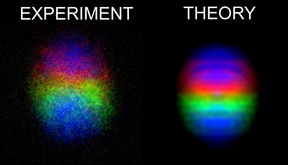Quantum-mechanical monopoles discovered

This discovery connects to important characteristics of the elusive monopole magnet. The results were just published in Science magazine.
The researchers performed an experiment in which they manipulated a gas of rubidium atoms prepared in a nonmagnetic state near absolute zero temperature. Under these extreme conditions they were able to create a monopole in the quantum-mechanical field that describes the gas.
‘In this nonmagnetic state, a structure was created in the field describing the gas, resembling the magnetic monopole particle as described in grand unified theories of particle physics. Previously, we have used the gas to detect a monopole within a so-called synthetic magnetic field, but there has been no monopole in the quantum field describing the gas itself. Now we have finally witnessed the quantum-mechanical monopole!’, enthuses Dr. Mikko Möttönen, Aalto University.
‘In the nonmagnetic state of the gas, no quantum whirlpools or monopoles are created in the synthetic magnetic field. However, quantum-mechanical magnetic order prevails in the sample, and we were able to manipulate this with adjustments to an externally applied magnetic field’, Möttönen continues.
‘The control of those magnetic fields must be stable to a small fraction of the size of the Earth's magnetic field’, adds Prof. David Hall, Amherst College. 'The main experimental challenge we faced is to prepare the ultracold gas under highly sensitive conditions, in which field fluctuations due to the motion of metal objects or power line variations can make observation of the monopoles difficult.', Hall continues.
The result is a remarkable step forward in quantum research. It is important to understand the structure of monopoles and other topological entities, in part because they appear in the models describing the early universe and affect the properties of many different materials, such as metals.
The discovery of a magnetic monopole particle is still in the future. This new result establishes that the structure of a quantum mechanical monopole does appear in nature, and therefore it further supports the possibility that magnetic monopoles exist.
Science article: M. W. Ray, E. Ruokokoski, K. Tiurev, M. Möttönen, and D. S. Hall
”Observation of isolated monopoles in a quantum field”
Science, DOI: 10.1126/science.1258289 (2015).
Link: http://doi.org/10.1126/science.1258289
See also the previous work of the team on a monopole in a synthetic classical-like field:
“Observation of Dirac Monopoles in a Synthetic Magnetic Field”, Nature 505, 657 (2014).
Contact details:
Mikko Möttönen, Docent, Dr.
Aalto University
Department of Applied Physics, QCD Labs
email: mikko.mottonen*at*aalto.fi
m. +358 50 594 0950
http://physics.aalto.fi/qcd/
Mikko Möttönen is the leader of the theoretical and computational part of the research. Theoretical ideas and computational modelling was very important for the success of the creation of the monopole. The modelling was carried out using the facilities at CSC — IT Center for Science Ltd and at Aalto University (Aalto Science-IT project).
David S. Hall, Professor
Amherst College
Department of Physics
Email: dshall*at*amherst.edu
p. +1 413 542 2072
http://www3.amherst.edu/~halllab/
David S. Hall is the leader of the experimental part of the research. The isolated monopoles were created in the Physics Laboratories at Amherst College, United States of America.
Funding: This material is based upon work supported by the National Science Foundation, the Academy of Finland, Finnish Doctoral Programme in Computational Sciences and the Magnus Ehrnrooth Foundation.
Read more news

Study: Internal combustion engine can achieve zero-emission combustion and double efficiency
A new combustion concept that utilizes argon could completely eliminate nitrogen oxide emissions from internal combustion engines and double their efficiency compared to diesel engines.
A new way to measure contagion: the gut bacterium behind blood poisoning can spread like influenza
Neither the antibiotic-resistant nor the highly virulent strains are the most transmissible.






